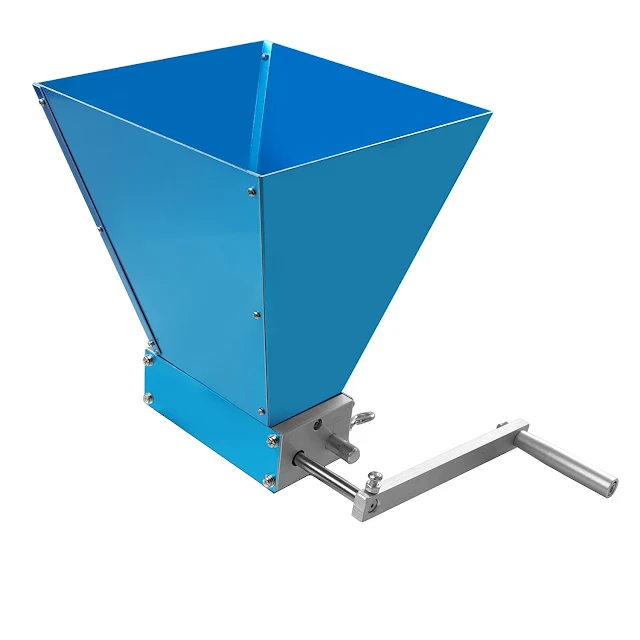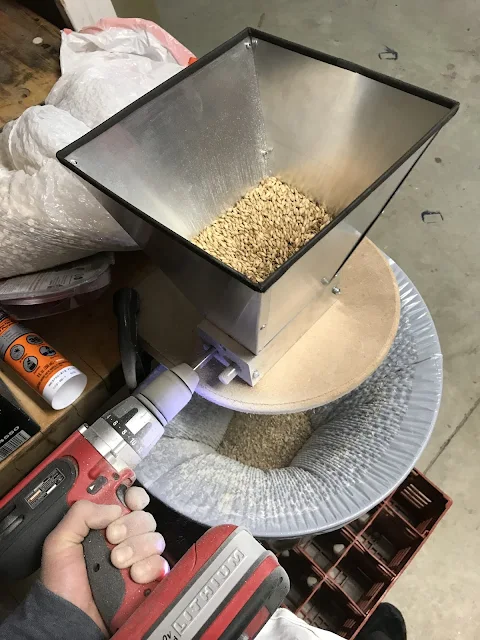Its origins relate to corn being the grist that was taken to the mill. In the more modern use, grist is something that is useful for a particular purpose.
This is just an excuse to talk about the best grist mills to mill grain with so that you can brew fabulous beers!
There's a little bit to think about when buying a mill and you should ask yourself the following kinds of questions
- Can the mill handle the volume of grain you want to run through?
- Can you adjust the mill gap to ensure the grains are cracked and not crushed?
- Can you upgrade it as you go along?
- How does it get mounted? Does it need or come with screws?
- How affordable is the unit?
- Do you plan to use it long-term, what are quality considerations?
Or you can just have a look and compare between these top-rated units:
Here's some specifications of these three handy mills.
The 'Barley Crusher'
Features:
- Solid base fits easily on a standard 6.5 gallon fermenting bucket.
- Adjustable rollers with a .015 to .070 range.
- Materials that will last a lifetime: 1018 Cold Rolled Steel for the rollers, 6061 Aluminum for the mill body and hopper, tool steel for the axles with oil-impregnated bronze bushings.
- 5-inch rollers have a 12 TPI knurl that pulls grain through while leaving the hull intact to form an excellent filter bed for sparging.
- Large hopper holds approximately 7 pounds of grain.
- Includes a hand-crank but no adapters are needed to use a 3/8 drill motor; using a 3/8 drill motor at 500 RPM gives a throughput of 6 pounds a minute.
Genuine Amazon reviews left by happy grain millers:
- "This mill pounds through grain like a champ. There's no going back to my old Corona mill."
- "The malt was nicely crushed, with husks moderately broken up, and endosperms exposed and cracked. My efficiency got a big boost- I got roughly 81% compared to the 63 to 73% I was getting before."
- "Far more than looks, this thing consistently and smoothly grinds my grains. I run the grain through twice and have the husks beautifully unbroken and ready for mashing."
- "Great barley crusher, very fast. This is great for increasing your mash efficiency."
Kegco KM7GM-2R Grain Mill
Featuring an alloy block frame that houses two steel rollers on stainless steel ball bearings. The drive shaft and all axles are integral to the roller, which makes it possible to drive the mill clockwise or counter-clockwise.
A traditional hand crank is included, but a handy feature is that the mill can be easily motorized with a drill. No extra parts or attachments are required, you simply attach the drill as you would a drill bit. Charge your drill battery well!
Stainless knurled knobs allow a gap spacing adjustment range of .070".
This unit is designed to crack grain, not flour.
Adjusting is simple - just loosen the adjustment screws, adjust the gap and tighten the adjustment screws. You will need to supply or build a base to set the mill over a grain bin or 5 gallon bucket. Sounds like a deal!
Ferroday Stainless 2-roller Homebrew Grinder
The Ferroday is a no-nonsense mill is made of hardened stainless steel, The roller size is 5" long and 1.25" in diameter and the crank shaft has a 3/8" diameter.
The roller is adjustable so you can select your crush settings. The unit weighs 6.6 pounds.
The roller is adjustable so you can select your crush settings. The unit weighs 6.6 pounds.
If you've got some questions about using mills, we've got the answers:
Why do I need to mill my grain?
A beer mill allows you to crack your grains right before you brew so that you can retain freshness. Possession of a mill will allow you enable you to purchase more affordable unmilled grain in bulk thus saving you money in the long run.
When should I mill the grain?
It's best to mill your grain as close as possible to brewing day. Many brewers do it a couple of days beforehand so that they don't have to do it on brewing day. It's a long process which just adds to the length of brew days - and those brewers who don't have eight hours on a Saturday to play around with, shorten the process by milling earlier.
If you are unable to actually mill your grain, you may want to delay your purchase as long as possible so that you can be confident that you have the freshest grains. If you are happy buying milled grain, then you may want to consider investing in a wort chiller or decent mash tun as they are crucial to brewing success.
Coarse or finely milled grain milling?
A grain mill that is appropriate for crushing barley for a mash is usually referred to as a 'grist mill'.
The mill needs to be set 'open' enough that the husk of the barley seed will crack open, but will not be torn apart. The goal of milling is to crack the grain kernels open, rather than pulverizing them into dust. By leaving the husks intact they serve as a filter bed during the sparge process.
Should you grind the grain much too finely, you run the risk of developing a stuck sparge, where the wort will not flow as intended through the grain.
Should you grind the grain much too finely, you run the risk of developing a stuck sparge, where the wort will not flow as intended through the grain.
Where should I mill grain?
Most brewers choose to mill outside, over a big bucket. The mess can begin when you dump the grain out of its sack - and that alone can justify your decision to mill outside!
Can I mash grain without a mill?
If you find yourself without a mill, you can try using a rolling pin. The rolling pin should at least crack the grain open. You might try crushing the grain on top of a thin towel.
The towel will stop the grain from rolling around while you try to crush it. This 'rolling pin method' is very time consuming so I'd personally discount it as a method for the long term.
Many a brave brewer has used a food processor and you can give it a whirl but be wary of over-processing the grain.
The electric KitchenAid mixers are a very popular family based home appliance - and a separately purchased mill attachment may be used to mill grain. It is however designed to mill flour for baking.Can I use the KitchenAid grain mill attachment?
Does it work is the real question?
The answer is that results may vary but you can use it.
Common brewer complaints about the Kitchenaid attachment are that is has a small hopper so it can be a timely exercise and it can be difficult to arrange a bucket under the attachment to collect the milled grain. Brewers who successfully use the item advise that one should not set the grain too fine and set it so the malt is barely cracked.
We the attachment will work best with the 600 watt Kitchen Aid mixer rather than the 325 watt unit.
How can I hook my drill up to the mill?
It's a simple trick to use your ordinary handyman drill to get the mill turning over. Here's a great example of how to set up the drill - et voila you suddenly have an electric mill:
Can I interest you in a ph Meter or the best burner for brewing with?
What about tips on keeping weevils from beer grain?
No? What about the recipe for making your own PBW cleaner? Kegco also make a handy 5 gallon keg.






0 comments:
Post a Comment